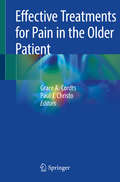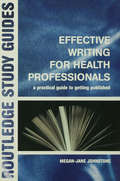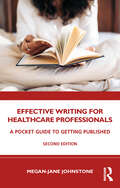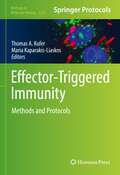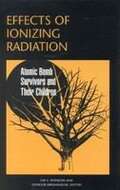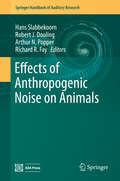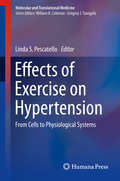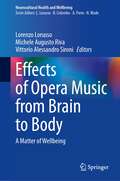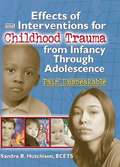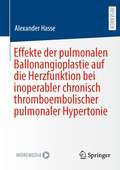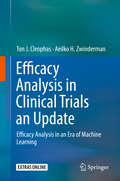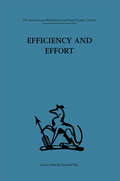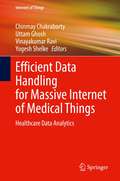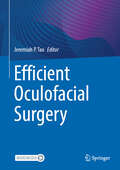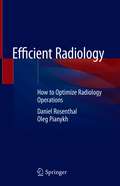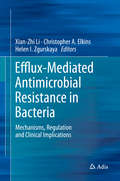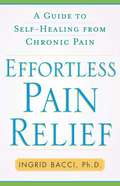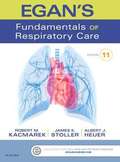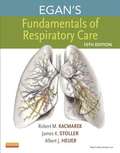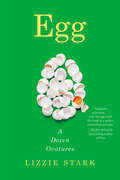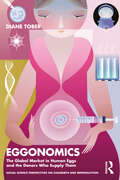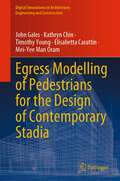- Table View
- List View
Effective Treatments for Pain in the Older Patient
by Grace A. Cordts Paul J. ChristoThis clinically focused book provides the essential modalities for managing pain in older patients. Chapters cover a variety of topics important for clinicians, including effective approaches, evaluation, acute and chronic pain, interventional strategies, and addiction issues. Complexities in assessing and treating pain when presented with multiple comorbidities and the unique physical, cognitive, and sensory changes that occur in the elderly are discussed in detail. Practical, concise and authored by leaders in pain medicine, this will serve as an invaluable guide to practitioners that care for older people.
Effective Treatments in Psychiatry
by Peter Tyrer Kenneth R. SilkTyrer (community psychiatry, Centre for Mental Health Imperial College, London, UK) et al. present this pocket (7x5") reference to effective psychiatric treatments. Covering a full range of disorders from schizophrenia and substance abuse disorders to anxiety and sexual identity disorders, this pocket reference provides brief information on each disorder as well as effective treatments. Drawing from the most recent psychiatric consensus, the material will be highly useful as an and up-to-date treatment reference for both psychiatry students and practitioners. Annotation ©2012 Book News, Inc. , Portland, OR (booknews. com)
Effective Writing for Health Professionals: A Practical Guide to Getting Published
by Megan-Jane JohnstoneHealth professionals are increasingly expected to conduct and publish their research, apply for grants, write newsletters, liaise with the media, present conference papers and contribute articles to professional journals. Writing well is an essential professional skill and writing to publish is an important aspect of professional development. But how do you get published? Where do you start? How do you know if your writing is good enough and what can you learn to make it better?Effective Writing for Health Professionals is an invaluable insider's guide to publishing within the health profession, providing handy tips on:· Getting started· The writing process· Winning habits of successful authors · Promoting your work · Author rights and responsibilitiesMany would-be writers - students, administrators, clinicians, managers and academics alike - are often intimidated at the thought of writing. This book will help to overcome this writing block and introduce aspiring authors to the world of writing and publishing in a professional capacity.Written by a best-selling academic author, Effective Writing for Health Professionals provides insights and strategies for publishing designed for nurses, midwives and health professionals.
Effective Writing for Healthcare Professionals: A Pocket Guide to Getting Published
by Megan-Jane JohnstoneThis new edition of Effective Writing for Healthcare Professionals is an invaluable insider's guide to publishing, providing tips and advice for time-poor professionals working in the healthcare sector. But how do you get published? Where do you start? How do you know if your writing is good enough and what can you learn to make it better? Offering an accessible guide to the key issues, this is the perfect book for those who have busy working lives and find the process of writing challenging. It covers issues ranging from getting started to the winning habits of successful authors; from the rights and responsibilities of authors to how to get noticed. This new edition has been updated to include guidance on publishing norms, collaborative digital platforms, social media, and the impact of the COVID-19 pandemic on publishing trends. Written by a best-selling academic author, this is an essential resource for novice writers and healthcare providers interested in publishing their work.
Effector-Triggered Immunity: Methods and Protocols (Methods in Molecular Biology #2523)
by Maria Kaparakis-Liaskos Thomas A. KuferThis volume presents a collection of protocols to study effector-triggered immunity (ETI) in both plants and animals from eminent groups in the field. The chapters in this book cover topics such as genetic manipulation of plant and animal pathogens, host cells, and the analysis of key host responses; and techniques used for the analysis of inflammasome activation, cell death pathways, and mitochondria damage in response to pathogens. All of these topics cover a broad spectrum of immunological, biochemical, cell biological, and structural biology approaches to examine ETI. Written in the highly successful Methods in Molecular Biology series format, chapters include introductions to their respective topics, lists of the necessary materials and reagents, step-by-step, readily reproducible laboratory protocols, and tips on troubleshooting and avoiding known pitfalls.Cutting-edge and practical, Effector-Triggered Immunity: Methods and Protocols is a valuable resource for both expert and novice researchers who are interested in learning more about the important and developing field of ETI.
Effects Of Ionizing Radiation: Atomic Bomb Survivors and Their Children (1945-1995)
by Leif E. Peterson Seymour AbrahamsonIn the decades since the atomic bombing of Hiroshima and Nagasaki, economic and political trends have opened avenues for radiation research while breakthroughs in molecular biology have shed light on radiation's effect on the human body. This volume comprehensively reviews what is now known about human exposure to ionizing radiation, with emphasis on unifying the scientific disciplines that inform this topic. Today's most widely recognized experts in the field examine four broad areas: Physics and dosimetry, including the various systems of A-bomb survivor dosimetry, the effect on survivors of subsequent medical radiation, and chromosome aberrations as biomarkers. Cancer statistics and epidemiology, including a historical review of leukemia risk in A-bomb survivors, the incidence of solid cancer and resulting mortality, and the results of studies of workers exposed to low-level radiation. Genetics, including the path from radiation exposure to cellular effects, carcinogenesis, and mutagenesis. Experts discuss the interaction between radiation and other cancer risk factors, review models of radiation-induced cancer, and report on other aspects of molecular biology. Psychological effects of radiation catastrophes--as seen at Hiroshima and Nagasaki, Three Mile Island, and Chernobyl--and consequences of the Atomic Bomb Survivors Relief Law.
Effects of Anthropogenic Noise on Animals
by Arthur N. Popper Richard R. Fay Hans Slabbekoorn Robert J. DoolingOver the past several years, many investigators interested in the effects of man-made sounds on animals have come to realize that there is much to gain from studying the broader literature on hearing sound and the effects of sound as well as data from the effects on humans. It has also become clear that knowledge of the effects of sound on one group of animals (e.g., birds or frogs) can guide studies on other groups (e.g., marine mammals or fishes) and that a review of all such studies together would be very useful to get a better understanding of the general principles and underlying cochlear and cognitive mechanisms that explain damage, disturbance, and deterrence across taxa.The purpose of this volume, then, is to provide a comprehensive review of the effects of man-made sounds on animals, with the goal of fulfilling two major needs. First, it was thought to be important to bring together data on sound and bioacoustics that have implications across all taxa (including humans) so that such information is generally available to the community of scholars interested in the effects of sound. This is done in Chaps. 2-5. Second, in Chaps. 6-10, the volume brings together what is known about the effects of sound on diverse vertebrate taxa so that investigators with interests in specific groups can learn from the data and experimental approaches from other species. Put another way, having an overview of the similarities and discrepancies among various animal groups and insight into the “how and why” will benefit the overall conceptual understanding, applications in society, and all future research.
Effects of Exercise on Hypertension
by Linda S. PescatelloAs the first primer on the effects of exercise on human hypertension, Effects of Exercise on Hypertension: From Cells to Physiological Systems provides the state-of-the-art effects of exercise on the many possible mechanisms underlying essential hypertension in humans. The book contains chapters by distinguished experts on the effects of exercise on physiological systems known to be involved in hypertension development and maintenance as well as less well known aspects of hypertension such as 24-hour ambulatory blood pressure profile and oxidative stress. An emerging area, the effects of resistance exercise training on blood pressure is also covered. A unique aspect of the book is that it covers the effects of exercise mimetics on vascular cell adaptations in order to begin to elucidate some of the cellular mechanisms that may underlie blood pressure reductions with exercise training. Lastly, the book will end with a chapter on the interactive effects of genes and exercise on blood pressure. Chapters are grouped by physiological system or mechanism. The text begins with two overview chapters; one on the general effects of aerobic exercise training and the second on the general effects of resistance exercise training on blood pressure. Each chapter begins with a bulleted list of key points. Effects of Exercise on Hypertension: From Cells to Physiological Systems will be of great value to professional individuals in cardiovascular medicine, the cardiovascular sciences, allied health care professionals, and medical and graduate students in the cardiovascular sciences and medicine.
Effects of Opera Music from Brain to Body: A Matter of Wellbeing (Neurocultural Health and Wellbeing)
by Lorenzo Lorusso Michele Augusto Riva Vittorio Alessandro SironiThis book explores the connection between melodrama and medicine from multiple perspectives. Neuroscientists study the relationship between opera and brain functioning in the light of new findings in the fields of neurophysiology, neuroimaging, cognitive science and neuro-musicology; clinicians investigate the therapeutic potential of music, especially in the field of treatment and rehabilitation of individuals with neurodegenerative diseases; medical historians analyse the representation of diseases and those who cure diseases within operas; occupational doctors report descriptions of diseases that affect workers in the opera world and particularly focus on psychiatric and psychological alterations. Opera, with its instrumental and vocal accompaniment, is considered the most complete form of theatrical performance. However, little is known about the mechanisms of brain activity under the influence of melodrama on singers, musicians, and listeners. The use of neuroimaging techniques has enabled a better understanding of the neuronal mechanisms and circuits involved during an opera performance. Over the past 20 years, melodrama has increasingly been used as a therapeutic approach in various neurological and neuropsychiatric pathologies, such as depression, cognitive impairment, and even coma. The book also discusses the ways in which melodrama affects professionals involved in music and interventions to reduce or alleviate occupational diseases, leading to improved health and higher life satisfaction. The ultimate goal is to improve therapeutic interventions in neurological diseases and professional disorders, relying on solid neuroscientific data. This book will be of great interest to neurologists, neurobiologists, psychiatrists, occupational doctors and therapists in music.
Effects of and Interventions for Childhood Trauma from Infancy Through Adolescence: Pain Unspeakable
by Sandra HutchisonSuccessfully reach out and help children through the worst times of their young lives! Effects of and Interventions for Childhood Trauma from Infancy Through Adolescence: Pain Unspeakable explores an array of trauma-related topics pertaining to children of all ages from a variety of cultures and countries. This book covers the various ego stages of child development and addresses how each one is affected by traumatic experiences. This easy-to-read resource serves as a readily available reference for caregivers-professional or otherwise-who work with or encounter a child who has been traumatized. In Effects of and Interventions for Childhood Trauma from Infancy Through Adolescence, you&’ll find actual accounts of traumatic incidents throughout the world, focused specifically on those incidents that have the most devastating impact on large groups of children. This book reviews the research on post-traumatic stress disorder and stress-response related symptoms with brief descriptions of treatments for you to use with children who suffer from posttraumatic stress. Special features of this important tool consist of with an extensive list of organizations and crisis hotline numbers as well as recommended reading, video, and curricula resources. Effects of and Interventions for Childhood Trauma from Infancy Through Adolescence examines traumatic situations from many angles, including: the many faces of trauma-accidents, fire, natural disasters developmental considerations, including ego development, memory development, and the development of fears and responses the way children respond to traumatic incidents the types of interventions-individual, group, family, pharmacological, and school-based cultural considerations from around the globe how to establish a school-based Trauma Response Team Effects of and Interventions for Childhood Trauma from Infancy Through Adolescence includes real case studies, fictional sample cases, and suggestions that walk you step-by-step through the possible scenarios that can occur with children during or after a traumatic event. Each section of the book ends with a helpful summary highlighting the most important information.
Effekte der pulmonalen Ballonangioplastie auf die Herzfunktion bei inoperabler chronisch thromboembolischer pulmonaler Hypertonie
by Alexander HasseDie chronisch thromboembolische pulmonale Hypertonie (CTEPH) ist eine relativ seltene, aber unterdiagnostizierte Erkrankung, die durch wiederholte Einschwemmungen von thrombotischem Material in die pulmonalarteriellen Gefäße charakterisiert ist. Unbehandelt hat die Erkrankung durch progredientes Rechtsherzversagen eine schlechte Prognose. Die CTEPH ist jedoch die einzige potenziell kurativ behandelbare Erkrankung aus dem Formenkreis der pulmonalen Hypertonie. Mittels pulmonaler Endarteriektomie können operable Patienten geheilt werden. Für das inoperable Drittel der Patienten bietet sich als radiologisch-interventionelles Verfahren die pulmonale Ballonangioplastie (BPA) an. Um den Therapieerfolg dieser Intervention zu messen und etwaige prognostische Aussagen treffen zu können, ist neben der klinischen Evaluation weiterhin der Rechtsherzkatheter als Goldstandard unumgänglich. Als invasives Verfahren birgt es jedoch die Gefahr ernsthafter Komplikationen. Als nicht invasives und somit sichereres und schneller durchführbares Verfahren eignet sich die kardiale Magnetresonanztomographie. Diese Studie überprüft mittels Volumetrie, Strainanalyse und kardialem Mapping nun zunächst, ob die BPA einen positiven Effekt auf die (Rechts-) Herzfunktion und pulmonale Hämodynamik hat. Ferner werden Korrelationen zwischen pulmonaler Hämodynamik und Strainparametern sowie T1- und T2-Zeiten überprüft und ermittelt, inwiefern sich die rechtsventrikuläre Strainanalyse zur Kontrolle der Therapieeffekte eignet.
Efficacy Analysis in Clinical Trials an Update: Efficacy Analysis in an Era of Machine Learning
by Aeilko H. Zwinderman Ton J. CleophasMachine learning and big data is hot. It is, however, virtually unused in clinical trials. This is so, because randomization is applied to even out multiple variables Modern medical computer files often involve hundreds of variables like genes and other laboratory values, and computationally intensive methods are required This is the first publication of clinical trials that have been systematically analyzed with machine learning. In addition, all of the machine learning analyses were tested against traditional analyses. Step by step statistics for self-assessments are included The authors conclude, that machine learning is often more informative, and provides better sensitivities of testing than traditional analytic methods do
Efficiency and Effort: An analysis of industrial administration
by W BaldamusTavistock Press was established as a co-operative venture between the Tavistock Institute and Routledge & Kegan Paul (RKP) in the 1950s to produce a series of major contributions across the social sciences. This volume is part of a 2001 reissue of a selection of those important works which have since gone out of print, or are difficult to locate. Published by Routledge, 112 volumes in total are being brought together under the name The International Behavioural and Social Sciences Library: Classics from the Tavistock Press. Reproduced here in facsimile, this volume was originally published in 1961 and is available individually. The collection is also available in a number of themed mini-sets of between 5 and 13 volumes, or as a complete collection.
Efficient Data Handling for Massive Internet of Medical Things: Healthcare Data Analytics (Internet of Things)
by Chinmay Chakraborty Uttam Ghosh Vinayakumar Ravi Yogesh ShelkeThis book focuses on recent advances and different research areas in multi-modal data fusion under healthcare informatics and seeks out theoretical, methodological, well-established and validated empirical work dealing with these different topics. This book brings together the latest industrial and academic progress, research, and development efforts within the rapidly maturing health informatics ecosystem. Contributions highlight emerging data fusion topics that support prospective healthcare applications. The book also presents various technologies and concerns regarding energy aware and secure sensors and how they can reduce energy consumption in health care applications. It also discusses the life cycle of sensor devices and protocols with the help of energy-aware design, production, and utilization, as well as the Internet of Things technologies such as tags, sensors, sensing networks, and Internet technologies. In a nutshell, this book gives a comprehensive overview of the state-of-the-art theories and techniques for massive data handling and access in medical data and smart health in IoT, and provides useful guidelines for the design of massive Internet of Medical Things.
Efficient Oculofacial Surgery
by Jeremiah P. TaoThis textbook provides an overview of minimal complexity “scalpel and suture” surgery with instruction on effective and direct surgical solutions. Interventions that avoid expensive or otherwise unavailable equipment, devices, or pharmaceuticals are highlighted throughout the textbook, for instance, with a focus on autologous grafts in lieu of implants or devices that add cost or complexity. Safe and efficient surgical treatments are featured in each chapter covering a complete spectrum of periorbital conditions. Efficient Oculofacial Surgery focuses upon safety and ergonomics measures that not only improve the quality of orbit, eyelid, and lacrimal surgeries, but also forestall serious misadventures such as an operating room fires or other iatrogenic patient injuries. In addition, concise tips and surgical pearls that add to the armamentarium of both novice and experienced surgeons are featured at the end of each chapter.
Efficient Radiology: How to Optimize Radiology Operations
by Daniel Rosenthal Oleg PianykhAiming at building efficient radiology operations, this book walks the reader through the entire radiology workflow, from the moment that the examination is requested to the reporting of findings. Using their practical experience, the authors draw attention to the many elements that can go wrong at each step, and explain how critical analysis and objective metrics can be used to fix broken processes. Readers will learn how to measure the efficiency of their workflows, where to find relevant data, and how to use it in the most productive ways. The book also addresses how data can be turned into insightful operational information to produce organizational change. All aspects of radiology operations are considered including ordering, scheduling, protocols, checking-in, image acquisition, image interpretation, communication, and billing. The closing section provides a deeper dive into the advanced tools and techniques that are used to analyze operations, including queuing theory, process mining and artificial intelligence.
Efflux-Mediated Antimicrobial Resistance in Bacteria
by Xian-Zhi Li Christopher A. Elkins Helen I. ZgurskayaThis book, written by leading international experts, provides a comprehensive, current examination of transport-mediated antimicrobial resistance. As a particularly powerful mechanism of multidrug resistance, an in-depth examination of efflux pumps is conducted with bacteria of major public health concern including Enterobacteriaceae, Acinetobacter, Neisseria, Pseudomonas, staphylococci, and mycobacteria. The content spans structural biochemistry and transport mechanisms of the major transporter families and considers individual drug efflux systems across various Gram-positive and Gram-negative species. Genomic analysis of efflux pump distribution and their contribution to clinically-relevant resistance are a major focus of the text. Moreover, interplay between drug efflux pumps and other key resistance mechanisms such as intrinsic drug impermeability, inactivation, and target alterations are discussed, as well as their molecular expression-based regulation and physiological functions beyond resistance, involving biofilms, stress response, and pathogenicity. Finally, strategies are addressed to target this drug resistance mechanism with novel antimicrobials or drug inhibitor adjuvants.
Effortless Pain Relief
by Ingrid Lorch BacciContrary to popular belief, the most frequent causes of neuromuscular, joint, or skeletal pain can be traced to your lifestyle: unconscious habits that involve the way you breathe, stand, and move and the way you store physical and emotional stress in your tissues. Given this fact, if you suffer from chronic pain, or treat people suffering from chronic pain, you may need to consider replacing expensive, often inefficient pain treatment with self-help methods for reversing the way physical, mental, and emotional stresses affect your muscles, joints, and bones. Effortless Pain Relief presents a unique mind-body program for overcoming chronic pain, developed by acclaimed alternative health-care practitioner Dr. Ingrid Bacci. In Effortless Pain Relief, you'll find a simple explanation of how stress creates chronic pain, along with clear, simple, and powerful self-help techniques for reducing and even eliminating pain. The guiding principle in this program for self-healing from chronic pain is to develop greater awareness of your body and sensitivity to it. You can change your lifestyle habits -- and eliminate your pain -- by adopting body awareness techniques that eliminate tension. Chapter by chapter, Effortless Pain Relief shows you how to release deep physical, mental, and emotional stresses through simple breathing techniques, to reduce consciously the effort and tension in your muscles, and to master and eliminate stressful emotions like fear and anger by learning to control the physical tensions that these feelings create. Dr. Bacci also guides you in a process that will allow you to let go of mental and emotional attitudes that unconsciously create stress and physical pain. She shows you how to release emotional conflicts that contribute to pain and teaches you how to conquer the fear of physical pain -- which can actually trigger pain. Dr. Bacci cites numerous case studies from the thousands of patients she has helped during the past fifteen years. She also tells the extraordinary story of her own complete recovery from three years of being bedridden and crippled from a severe case of the chronic pain syndrome fibromyalgia. The curative techniques through which she healed herself, and with which she has helped her thousands of clients achieve freedom from pain, are now available for everyone in Effortless Pain Relief. Dr. Bacci's groundbreaking, accessible program offers deceptively simple yet profoundly effective ways to leave pain behind, enhance your vitality, and find an effortless route to a pain-free life.
Effortless Pain Relief
by Ingrid Lorch BacciContrary to popular belief, the most frequent causes of neuromuscular, joint, or skeletal pain can be traced to your lifestyle: unconscious habits that involve the way you breathe, stand, and move and the way you store physical and emotional stress in your tissues. Given this fact, if you suffer from chronic pain, or treat people suffering from chronic pain, you may need to consider replacing expensive, often inefficient pain treatment with self-help methods for reversing the way physical, mental, and emotional stresses affect your muscles, joints, and bones. Effortless Pain Relief presents a unique mind-body program for overcoming chronic pain, developed by acclaimed alternative health-care practitioner Dr. Ingrid Bacci. In Effortless Pain Relief, you'll find a simple explanation of how stress creates chronic pain, along with clear, simple, and powerful self-help techniques for reducing and even eliminating pain. The guiding principle in this program for self-healing from chronic pain is to develop greater awareness of your body and sensitivity to it. You can change your lifestyle habits -- and eliminate your pain -- by adopting body awareness techniques that eliminate tension. Chapter by chapter, Effortless Pain Relief shows you how to release deep physical, mental, and emotional stresses through simple breathing techniques, to reduce consciously the effort and tension in your muscles, and to master and eliminate stressful emotions like fear and anger by learning to control the physical tensions that these feelings create. Dr. Bacci also guides you in a process that will allow you to let go of mental and emotional attitudes that unconsciously create stress and physical pain. She shows you how to release emotional conflicts that contribute to pain and teaches you how to conquer the fear of physical pain -- which can actually trigger pain. Dr. Bacci cites numerous case studies from the thousands of patients she has helped during the past fifteen years. She also tells the extraordinary story of her own complete recovery from three years of being bedridden and crippled from a severe case of the chronic pain syndrome fibromyalgia. The curative techniques through which she healed herself, and with which she has helped her thousands of clients achieve freedom from pain, are now available for everyone in Effortless Pain Relief. Dr. Bacci's groundbreaking, accessible program offers deceptively simple yet profoundly effective ways to leave pain behind, enhance your vitality, and find an effortless route to a pain-free life.
Egan's Fundamentals Of Respiratory Care
by Robert Kacmarek James Stoller Albert HeuerDesigned for optimal student learning for over 40 years, Egan’s Fundamentals of Respiratory Care, 11th Edition provides you with the strong background you need to succeed in the field of respiratory care. Nicknamed "the Bible for respiratory care," it helps you gain a thorough understanding of the role of respiratory therapists, the scientific basis for treatment, and clinical applications. Comprehensive chapters correlate to the most up-to-date 2015 NBRC Detailed Content Outline for the TM-CE to successfully prepare you for clinical and credentialing exam success. Always in step with the ever-changing field of respiratory care, this easy-to-read new edition features five new chapters, as well as new information on online charting systems, patient databases, research databases, meaningful use, simulation, and an expanded discussion of the electronic medical record system.
Egan's Fundamentals of Respiratory Care (10th Edition)
by Robert M. Kacmarek James K. Stoller A. H. HeuerA leader in respiratory care education for more than 40 years, Egan's Fundamentals of Respiratory Care, 10th Edition delivers a comprehensive introduction to the field of respiratory care and keeps you up-to-date on the latest advances and trends in professional practice today. With this new edition, you'll gain a thorough understanding of the role of respiratory therapists (RTs), scientific bases for treatment, and clinical applications. In-depth discussions progress from the principles of respiratory care to applied anatomy and physiology, assessment, discussion of specific respiratory illnesses, basic therapy, acute and critical care, and preventive and long-term care. Egan's is the most recommended and trusted text for NBRC examination preparation. UNIQUE! Egan's trusted reputation as the preeminent fundamental respiratory care textbook delivers comprehensive coverage while keeping you up to date with this ever-changing profession. UNIQUE! Expert authorship from the leading figures in respiratory care ensures critical content is covered thoroughly and accurately. UNIQUE! Mini Clinis give you an opportunity to apply text content to actual patient care through short, critical-thinking vignettes. UNIQUE! Rules of Thumb highlight rules, formulas, and key points that are important to clinical practice. Excerpts of all 49 published Clinical Practice Guidelines provide you with important information regarding indications/contraindications, hazards and complications, assessment of need, and assessment of outcome and monitoring. Therapist Driven Protocols (TDPs) used by RTs in hospitals to assess patients, initiate care, and evaluate outcomes, are incorporated throughout the text to demonstrate the value of following an established protocol. Learning Objectives highlight key content at the beginning and at the end of each chapter in a bulleted section and parallel the three areas tested on the NBRC exam: recall, analysis, and application. Updated content aligned with the 2009 NBRC CRT Summary Content Outline ensures the text is both current and clinically accurate. Expanded use of the NBRC Exam Matrix Correlation Chart throughout all Evolve online resources makes test preparation easier.
Egg: A Dozen Ovatures
by Lizzie Stark“Endlessly surprising.… Like the egg itself, this book is a perfect, miraculous package.” —Mary Roach, best-selling author of Fuzz An unconventional history of the world’s largest cellular workhorse, from chickens to penguins, from art to crime, and more. The egg is a paradox—both alive and not alive—and a symbol as old as culture itself. In this wide-ranging and delightful journey through its natural and cultural history, Lizzie Stark explores the egg’s deep meanings, innumerable uses, and metabolic importance through a dozen dazzling specimens. From Mali to Finland, mythologies around the globe have invested the egg with powers of regeneration and fecundity, often ascribing the origin of the world to a cosmic egg. An oracle to Romans, fought over by Gold Rush gangs, used as the foundation of the Clown Egg Registry, and blasted into space, the egg has taken on larger proportions than, say, the ovum of an ostrich. It has starred in global dishes from the Korean comfort food ttukbaegi gyeranjjim to the less regaled yet iconic soft-boiled egg. Stark writes a biography of French-born chef Jacques Pépin through his egg creations, and weaves in her personal experiences, like attempting to make the perfect omelet or trying her hand at pysanky—the Ukrainian art of egg decoration. She also explores her fraught relationship to the eggs in her body due to a familial link to cancer, and shares her delight in becoming a mother. Filled with colorful characters and fascinating morsels, Egg is playful, informative, and guarantees that you’ll never take this delicate ovoid for granted again.
Eggonomics: The Global Market in Human Eggs and the Donors Who Supply Them (Social Science Perspectives on Childbirth and Reproduction)
by Diane M. ToberWhat happens when people are reduced to products? By pulling back the clinical curtain on the multi-billion-dollar per year global egg industry, that is the central question Eggonomics seeks to address. Tracing the emotional and physical journeys egg donors embark upon as suppliers of valuable commodities, this book reveals uncomfortable realities at the heart of the industry. Donors — and the eggs they provide — are absolutely essential to helping others create the families of their dreams. But not all clinics treat their donors as well as their paying patients, and many donors suffer as a result. Technological innovations allow the egg donation industry to expand, fueling the private equity incursion into fertility medicine, turning once-private clinics into highly profitable, multinational conglomerates. Drawing upon international anthropological fieldwork, Eggonomics reveals the clinical spaces where egg donor’s bodies are tested, prodded, and poked for ever-increasing sums of profit, eugenic forces drive donor selection, and the unrelenting pressures of global capitalism threaten medicine’s prime directive of ‘do no harm.’ Timely, meticulously researched, and written with surgical precision, Eggonomics is a crucial read for researchers, medical professionals, policymakers, and anyone considering becoming or using an egg donor.
Ego States: Theory and Therapy
by John G. Watkins Helen H. WatkinsDescribes techniques of brief hypnoanalysis that the authors have developed based largely on the psychoanalytic ego psychology of Paul Federn.
Egress Modelling of Pedestrians for the Design of Contemporary Stadia (Digital Innovations in Architecture, Engineering and Construction)
by Timothy Young John Gales Kathryn Chin Elisabetta Carattin Mei-Yee Man OramThis book provides an understanding of people's accessibility needs, and the barriers that may affect people with different identities and circumstances (e.g. different levels of mobility, age, etc.) to alleviate any act of disabling a person and thus offer equal quality of life in the design of stadia. A lack of knowledge exists for stadia concerning demographics, specific accessibility and inclusive design solutions, available movement and behavioural data, and how future growth in attending disabled populations may affect the overall safety of circulation and evacuation in stadia. To address these needs a data collection and modelling were performed and are described in this book. The book recognizes that stadia design is at a revolutionary stage of advancement. Automated data collection technologies and methodologies are described where the authors work towards presentation of big data which can be used for future refinement of modelling technologies and AI routines.
